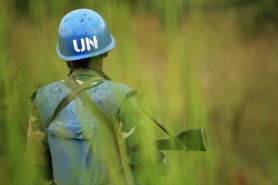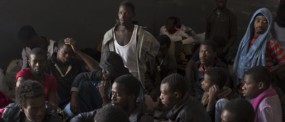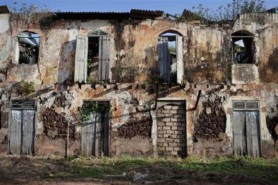Posted on 04 Apr 2019
The Global Initiative recently published an article (When the Peacekeepers are Part of the Problem) that examines the 2018 iteration of the UNODC’s Global Report on Trafficking in Persons. Acts of exploitation and abuse that have been reportedly carried out by UN peacekeepers in conflict zones, including areas where human trafficking is an existing humanitarian problem, are not addressed in the UNODC report. This article looks at the Central African Republic, one setting where such transgressions by members of the UN have been allegedly committed.
Human trafficking has emerged as one
of this millennium’s major humanitarian crimes. Since the rebranding of some of
the worst forms of human exploitation as ‘trafficking’ in the UN Convention on Transnational
Organized Crime, and the Protocol to Prevent, Suppress and Punish Trafficking
in Persons (2000), trafficking has earned a reputation as a hidden crime
perpetrated by shadowy criminal networks. The stereotypes of women abducted,
drugged and forced to work in brothels, or orphaned children made to work for
no pay in sweatshops, have steadily captured the world’s attention.
But the international community is only just starting
to realize how narrow our original conceptions of trafficking are. The
exploitative trafficker–hoodwinked victim narrative and ‘hidden’ crime rhetoric
frequently fail to capture the magnitude and reality of human trafficking.
One emerging issue is the level of human trafficking
that happens in contexts of humanitarian crisis and conflict settings. High-profile
cases, such as the Islamic State’s capture and enslavement of Yazidi women and
girls, and the mass kidnapping of the Chibok schoolgirls by Boko Haram in 2014,
have galvanized the UN into action. The UN Security Council has issued two
Resolutions, 2331
(2016) and 2388
(2017), tasking the international community to work
together to address trafficking in conflict, especially, as it relates to
activities of terrorist groups.
Yet, although human trafficking in conflict has now become
a priority, the resolutions have not translated into sufficient action. Nowhere
is it more evident of how short we are falling than in the Central African
Republic (CAR), ranked
third on a list of the
world’s most neglected human-displacement crises.
The CAR is a nation steeped in
violence. After four years of conflict, human trafficking has become a mainstay
of the war economy. Women are forced into early and servile marriages; children
are forcibly recruited into armed groups; and thousands of people are forced to
work in hazardous conditions in the country’s diamond mines. Here, there is
nothing hidden about human trafficking, and it defies all stereotypes: it
is an omnipresent force affecting large segments of the population, and it is
on public display. When human trafficking ceases to be carried out in the
shadows, and instead is allowed to become a commonplace activity, we must ask
ourselves how genuinely dedicated the international community is to defeating it.
The factors driving the crisis in the CAR
increase vulnerability to trafficking: a corrupt, non-functioning government,
deepening sectarian divides that border on ethnic cleansing and foreign
intervention for control of the country’s valuable mineral resources. The two
opposing factions that have formed from CAR’s divided ethnic groups – the
majority Christian Anti-Balaka, and the Muslim Séléka – are responsible for
gross atrocities, including torture, gang rape and mass mutilations. Trafficking
is used as a tactic to terrorize and intimidate the population, and as a means
to financially and socially support the war economy.
With the conflict
creating crippling poverty, women and girls are highly vulnerable to
trafficking, and readily exploited by the vying militia groups. In a country
where early and forced marriages were already rife – 29%
of girls are married by the age of 15 and a staggering 68% by the time they are
18 – militia groups have seized upon the opportunity to abduct and forcibly
marry girls to fighters. By law, in the CAR a
girl can legally marry at any age if she is pregnant – a loophole that has ‘legitimized’
civilians’ and militias’ mistreatment of girls. Here, in the absence of international
outrage, trafficking is normalized: it is there for all to see and it is
largely ignored. This strongly contrasts with the case of Boko Haram and the
Chibok schoolgirls: what was met with an international outcry in Nigeria largely
goes unnoticed in the CAR.
Boys face a
different, but equally exploitative form of human trafficking as child soldiers.
Recruited from remote and pillaged villages or refugee camps, boys are valuable
commodities sought by militias. Often coerced with the promise of money, or
abducted and proselytized, boys from as young as eight are trained to kill.
Often armed only with knives, they are either sent
to the front line or used as shields, indicative of how cheap young lives have
become.
The deployment
of forced labour in CAR’s diamond mines finances the war effort on both sides. The
miners, mostly men and boys, are exploited either by being forced to work for
the militias, robbed by them or by being compelled to pay protection taxes. A
significant portion of the mining zones are under militia control; the Anti-Balaka
occupy the Boden-Guen-Carnot axis in the west, while the Séléka occupy the east.
The labourers experience hazardous and gruelling work conditions, little to no
pay and high risk of injury or death. International commitments to clean up
diamond supply chains, through initiatives such as the Kimberley
Process, allowing trade only from compliant zones, have had the effect of
redirecting sales into smuggling and the black market. This type of human
trafficking is more discreet and masked as cheap labour, largely ignored and almost
never reprimanded.
The local and
international response to trafficking in persons in the country is negligible:
there have been no reported
cases of trafficking in CAR, and trafficking in persons is not explicitly
mentioned in UN mandates, or in the UN Multidimensional Integrated Stabilization
Mission in CAR (MINUSCA), which is tasked with protecting civilians there.
But perhaps the
most concerning aspect is the fact that the international community is delegating
the protection of CAR civilians to an entity some of whose members have been accused
of committing crimes against the very people they are mandated to protect. As our earlier report emphasizes,
there is evidence of criminal misconduct having been committed by UN personnel
in conflict zones, with over 100 cases of abuse reported against UN members since 2014. One case,
reported by MINUSCA, involved the alleged rape and subsequent pregnancy of a 14-year-old
child in the CAR by a former
member of MINUSCA’s military battalion.
UN peacekeepers have a duty to protect
vulnerable communities in their transition to peace, and there are arguably
none more vulnerable than the CAR. The UN professes a zero-tolerance policy on abuse and sexual
exploitation, yet the victims of abuse by its personnel may be more numerous
than reported.
The CAR serves
as a clear example that, while many pledges to stop human trafficking have been
made, the situation on the ground remains dire and efforts to combat it
insufficient.



